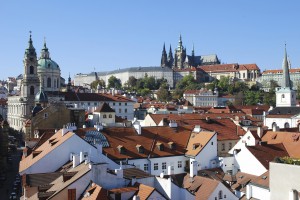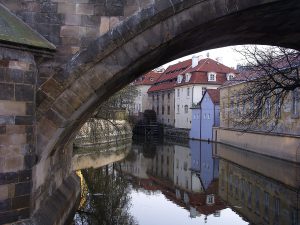Prague´s Lesser Town
By Erin Naillon
Prague’s Lesser Quarter has had an interesting past. The area, located below Prague Castle and extending along the Vltava River, was originally a series of small settlements outside the castle fortifications. At that time, the population was mostly ethnic German, merchants who had been invited by King Přemysl Otakar II. The town was ravaged by fire in a Hussite battle in 1419, then again in the fire of 1541, which also damaged St. Vitus’ Cathedral.
 Malé Město Pražské (Prague Lesser Town)
Malé Město Pražské (Prague Lesser Town)
In the year 1257, these settlements were consolidated, and a separate royal town was formed. Originally called Malé Město Pražské (Prague Lesser Town), the name eventually changed to Malá Strana (Lesser Quarter). The quarter houses many magnificent buildings once owned by the nobility, such as Valdštejn (Wallenstein) palace. Many of these ornate structures stand on the sites of older buildings that were destroyed during the Thirty Years’ War when invading Swedish troops ravaged Malá Strana, destroying houses, stealing garden statues, and damaging the tower on that side of the Charles Bridge.
Alchemists
Self-professed alchemist and accomplished con man Edward Kelley owned a house on a Malá Strana side street halfway up the hill to Prague Castle. The house, still standing, has a tower that Kelley used to study the stars. Legend has it that a woman living across the courtyard took a breather from caring for her sick baby one night when she saw Kelley at the top of his tower. The wind blew Kelley’s hair back, revealing that he had no ears (they had been sliced off in England when he committed the crime of forgery). The woman called to him, “Master, help me! My child is sick!” Kelley, furious, shouted back, “Go away! Your child will have the head of a donkey!” The horrified woman rushed back into her house, only to find that Kelley’s prophecy was correct. The following morning, she visited the church across the street to pray that her child would be healed. When she returned home, the baby was normal once more. (Kelley’s stepdaughter Elizabeth, a talented writer of Latin verses, is buried in St. Thomas’ Church just off the main square.)
The Wallenstein Palace
The Wallenstein Palace, currently the home of the Czech Senate, is yet another of the lavish homes built by Czech nobility in the Lesser Quarter. Albrecht von Wallenstein destroyed twenty-six homes, six gardens, and two brickworks in order to clear the land for his Italianate home. During the Thirty Years’ War, Wallenstein was assassinated in Cheb, near the modern-day Czech/German border. His magnificent house was looted by the Swedes. These days, the gardens of the palace are open to the public; fans of the film Immortal Beloved will recognize them easily.
The Lesser Quarter Square
The Lesser Quarter Square (Malostranské náměstí) is a smaller square, especially by Prague standards, but is ringed by a series of architectural jewels, including the 13th-century St. Nicholas Cathedral, which dominates the main square. This imposing building started as a small parish church and was turned into the current gorgeous structure in the 18th century by well-known architect Kilian Ignac Dientzenhofer. The organ was once played by none other than Mozart himself, on a trip to Prague.
Infant Jesus of Prague
Another, the Church of Our Lady Victorious, is well-known to Catholics as the home of the Infant Jesus of Prague. The Infant survived pillaging by the Swedes and being thrown in a pile of trash behind the altar to become a popular pilgrimage site. Many miracles are said to have taken place in Infant’s presence.
John Lennon Wall
A shrine of a very different kind is found in an area of Malá Strana not far from the river. This is the John Lennon Wall, covered with Lennon graffiti dating back to the time of Lennon’s death in 1980. Lennon’s fans painted the wall as a form of protest against the regime of that time, as well as a way of paying tribute to their idol. The police repainted the wall time and again, but the graffiti always reappeared. With the coming of democracy, Czechs and foreigners alike added their own touches to the wall, which is never repainted now – at least, not by the police.
Petřin Hill
Petřin Hill, above much of the Lesser Quarter, has a small replica of the Eiffel Tower. The hill contains extensive parks, and walkers can journey downhill – or uphill – along the various paths. Less hardy travelers can take the funicular. A mirror maze is located not far from the tower, and Stations of the Cross line one of the paths at the top of the hill. Further down, a statue of the poet Karel Hynek Mácha, author of the popular poem Máj, is a favorite spot for lovers. On the first of May, couples flock here to kiss in front of the statue, which is believed to cause lifelong fidelity.
 Kampa Island
Kampa Island
The Lesser Quarter also offers Kampa Island, home to some fine restaurants, and Museum Kampa, an art museum displaying works by Czech and international artists. Swans glide around the island looking for a handout, and boats are available for rent in good weather.




